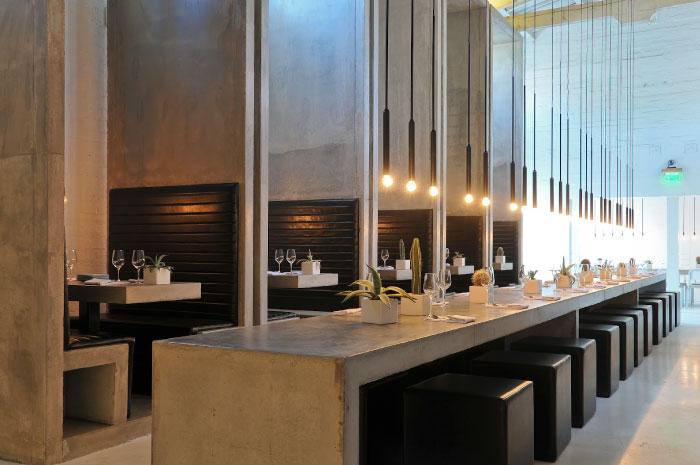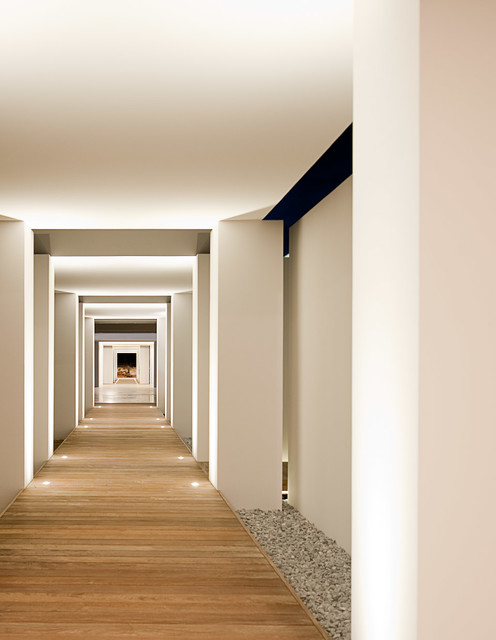Chevron patterns on both your sofa and wall tapestry a series of similar vases lining a mantle or a stack of books on a shelf. You can begin by placing small to large decorative objects in a room that ultimately lead to the grand focal piece.

Interior Design Principles Rhythm Art Life Fun New Zealand
Repetition alternation and progression.

. Proportion refers to how the elements within an object relate to the object as a whole while scale. Examples of this method are placing 4 to 6 matching picture frames with similarly photos in them on the wall above your couch in the living room. Look at the columns supporting the aqueduct below.
Rhythm is how well you execute repetition. Applying these visual mechanisms will. Rhythm is defined as organized repetition or movement.
It can also be created by progression which is simply a gradual increasing or decreasing in size direction or color. It gives the home interior the extra hint of polish and considered to be the secret behind the success of every interior design. In interior design rhythm is all about repetition of design elements that help to create movement within a space.
Repetition is the use of the same object several times. Your eye immediately scans down to the arch at the very end. Balance depends upon visual weights of the architectural and interior elements -- visual weight is determined by the psychological impact an element makes on us and the the attention it demands.
Employing a design element a shape for. Rhythm is created through repetition of line form texture and color. Serious interior designers should not stop until they feel the appropriate level of rhythm was achieved within a space.
Progression is also possible with a play of light and colours. Analyzing a piece of music we would describe its rhythmic pattern. See more of radiation rhythm on facebook.
Repetition and alternation Progression or gradation Transition Opposition or contrast Radiation Repetition Repetition is a common means of creating rhythm and moving the eye through a space. The importance of rhythm in interior design. Well start by defining rhythm within design.
1280 x 720 jpeg 456 кб. It carries the eye along a path at a pace that is comfortable for the viewer. Using a step-by-step progression to move the eye from one end of the space to the other.
Rhythm by gradation or progression. When this principle is applied to music think of the repeated beat in a song that created a musical pattern. In order to achieve rhythm in your own homes design youll have to think about repetition progression transition and contrast.
Rhythm via Progression Progressing through the room in terms of shapes sizes or colours is also one way to bring a rhythmic feel to the interior. Rhythm may be applied in bold statements that make an obvious suggestion about a path of travel or more subtly applied to move your eye about a space without you even realizing the rhythm is there. Rhythm created by a gradual change in size or color.
There are three main ways to incorporate rhythm into your homes layout. When applied to an interior design rhythm is achieved by the repetitive use of. Balance Rhythm Emphasis and Harmony.
It is actually a subtle pattern that takes all of the individual design elements and binds them together. Incorporating these mechanisms into your interior youll be able to create a sense of. The essence of rhythm in interior design is visual repetition of form.
This will establish the balance in your space while creating the rhythm you desire. The barajas airport by richard rogers and estudio lamela is an excellent example of rhythm achieved through repetition and progression of colour. Using these methods will create rhythm through continuity and interest.
N The floor design the windows furnitures etc in redial rhythm 23. Rhythm The rhythm of a room involves how the elements within it move together. In interior design rhythm is all about repetition of design elements that help to create movement within a space.
What is balance in design. Repetition is the simplest way to attain rhythm and can be similarly-themed homeware and. Repetition uses repeated elements of the rooms design in a regular recognizable way.
Traditionally there are three types of rhythm you can use in your interior design. Progression rhythm in interior design Written By waymer Friday March 11 2022 Add Comment Balance Rhythm Emphasis and Harmony. The forth principle of design is proportion and scale.
Gradation Radiation and Opposition. 5 Ways Rhythm Engages Your Eye The Core Elements of Interior Design. The principles of design relate to how you use these elements.
Whether visual or auditory the principle of rhythm repetition and movement is defined as a sound or sight that is repeated in an orderly fashion. Repeating a continuous pattern throughout the space to create a sense of stability. Weve always thought rhythm was the most confusing of all of the principles.
Rhythm can be created with patterns color structure size or texture. In interior design rhythm is all about repetition of design elements that help to create movement within a space. There are five flavors of rhythm.
The principles of interior design are balance emphasis rhythm proportion and scale and harmony and unity. Today she will cover the final principal of interior design. There are three methods of achieving rhythm in interior design.
Then take a step back. A space that has steady rhythm and repetition will lead the eye around the room seamlessly. Suggests connected movement between different elements of interior design.
A central piece of art or furniture plays the role of a focal point or attention grabber. Explore the definition and examples of dissonance in classical and popular music. Progression repetition the repeated use of certain objects or physical attributes of decor elements.
It allows for unity and evolving variety in a design. Rhythm and repetition is the idea of creating movement and harmony throughout your space with recurring patterns colors and different elements. Other items around the focal point are used to complement it.
To achieve a rhythm effect in your design you need to think about design elements or decor in repetition progression transition or contrast. Rhythm Rhythm is the flow from one design element to the next assisting the eyes to move freely throughout an interior environment. The proper use of this principle will create excitement and interest within a space.
The flow of elements usually organized according to a scheme such as repetition or alternation progression or graduation transition opposition or contrast or radiation. Elements can be repeated alternated or arranged in progression to maintain a visual tempo Emphasis. Like rhythm in music rhythm in design brings a sense of movement to a space.
Rhythm may be applied in bold statements that make an obvious suggestion about a path of travel or more subtly applied to move your eye about a space without you even realizing the rhythm is there. A state of equalibrium of the visual forces in a composition. Repetition Transition and Progression Also known as Gradation.
Here are 5 design principles of Rhythm you can use to create flow throughout your interiors. In interior design rhythm is one of the fundamental elements.

Principles Of Interior Design Part 2 Rhythm

Rhythm By Repetition 2 Achieved By Repeating Color Line Form Or Texture Architecture Architecture Design Architect House

What Is Rhythm In Interior Design Learn To Apply Tilen Space

How Does Rhythm In Design Engage Your Eyes Your Own Unique Decor

Principles Of Interior Design Part 2 Rhythm

5 Ways Rhythm Engages Your Eye

How Does Rhythm In Design Engage Your Eyes Your Own Unique Decor

0 comments
Post a Comment